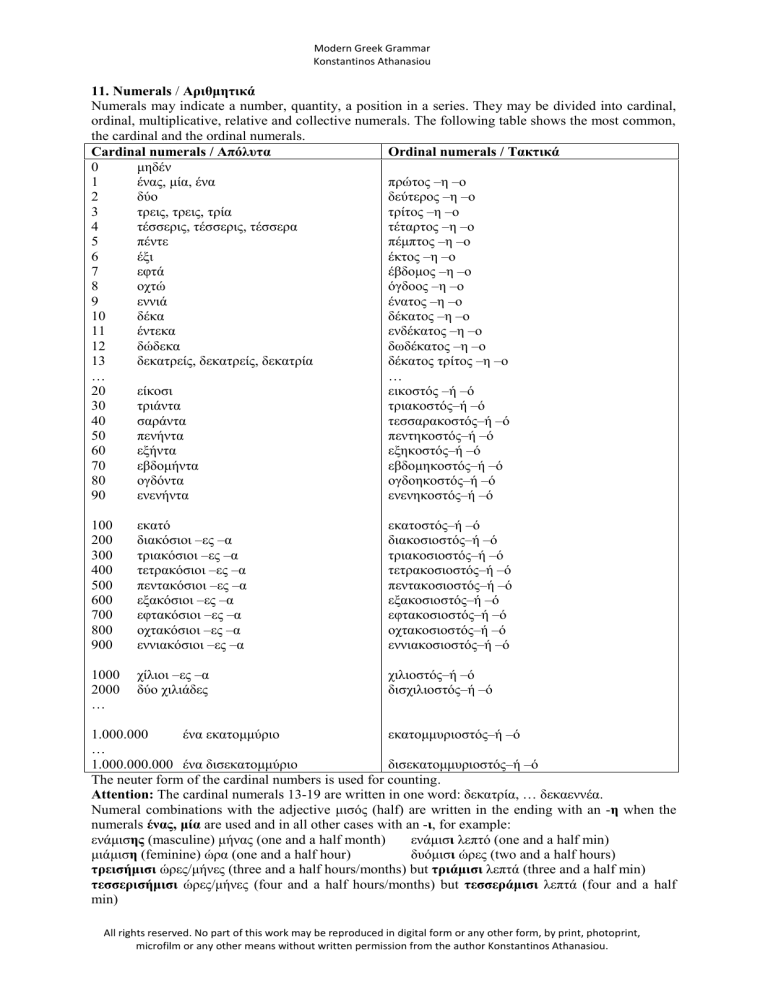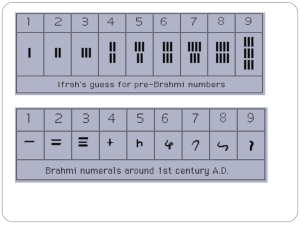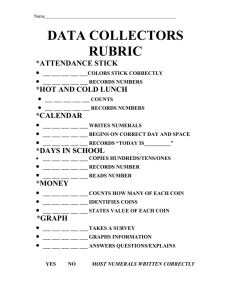Modern Greek Numerals: Grammar Lesson
advertisement

Modern Greek Grammar Konstantinos Athanasiou 11. Numerals / Αριθμηηικά Numerals may indicate a number, quantity, a position in a series. They may be divided into cardinal, ordinal, multiplicative, relative and collective numerals. The following table shows the most common, the cardinal and the ordinal numerals. Cardinal numerals / Απόλσηα Ordinal numerals / Τακηικά 0 μηδέν 1 έναρ, μία, ένα ππώηορ –η –ο 2 δύο δεύηεπορ –η –ο 3 ηπειρ, ηπειρ, ηπία ηπίηορ –η –ο 4 ηέζζεπιρ, ηέζζεπιρ, ηέζζεπα ηέηαπηορ –η –ο 5 πένηε πέμπηορ –η –ο 6 έξι έκηορ –η –ο 7 εθηά έβδομορ –η –ο 8 οσηώ όγδοορ –η –ο 9 εννιά έναηορ –η –ο 10 δέκα δέκαηορ –η –ο 11 ένηεκα ενδέκαηορ –η –ο 12 δώδεκα δωδέκαηορ –η –ο 13 δεκαηπείρ, δεκαηπείρ, δεκαηπία δέκαηορ ηπίηορ –η –ο … … 20 είκοζι εικοζηόρ –ή –ό 30 ηπιάνηα ηπιακοζηόρ–ή –ό 40 ζαπάνηα ηεζζαπακοζηόρ–ή –ό 50 πενήνηα πενηηκοζηόρ–ή –ό 60 εξήνηα εξηκοζηόρ–ή –ό 70 εβδομήνηα εβδομηκοζηόρ–ή –ό 80 ογδόνηα ογδοηκοζηόρ–ή –ό 90 ενενήνηα ενενηκοζηόρ–ή –ό 100 200 300 400 500 600 700 800 900 εκαηό διακόζιοι –ερ –α ηπιακόζιοι –ερ –α ηεηπακόζιοι –ερ –α πενηακόζιοι –ερ –α εξακόζιοι –ερ –α εθηακόζιοι –ερ –α οσηακόζιοι –ερ –α εννιακόζιοι –ερ –α εκαηοζηόρ–ή –ό διακοζιοζηόρ–ή –ό ηπιακοζιοζηόρ–ή –ό ηεηπακοζιοζηόρ–ή –ό πενηακοζιοζηόρ–ή –ό εξακοζιοζηόρ–ή –ό εθηακοζιοζηόρ–ή –ό οσηακοζιοζηόρ–ή –ό εννιακοζιοζηόρ–ή –ό 1000 2000 … σίλιοι –ερ –α δύο σιλιάδερ σιλιοζηόρ–ή –ό διζσιλιοζηόρ–ή –ό 1.000.000 ένα εκαηομμύπιο εκαηομμςπιοζηόρ–ή –ό … 1.000.000.000 ένα διζεκαηομμύπιο διζεκαηομμςπιοζηόρ–ή –ό The neuter form of the cardinal numbers is used for counting. Attention: The cardinal numerals 13-19 are written in one word: δεκαηπία, … δεκαεννέα. Numeral combinations with the adjective μιζόρ (half) are written in the ending with an -η when the numerals ένας, μία are used and in all other cases with an -ι, for example: ενάμιζης (masculine) μήναρ (one and a half month) ενάμιζι λεπηό (one and a half min) μιάμιζη (feminine) ώπα (one and a half hour) δςόμιζι ώπερ (two and a half hours) ηρειζήμιζι ώπερ/μήνερ (three and a half hours/months) but ηριάμιζι λεπηά (three and a half min) ηεζζεριζήμιζι ώπερ/μήνερ (four and a half hours/months) but ηεζζεράμιζι λεπηά (four and a half min) All rights reserved. No part of this work may be reproduced in digital form or any other form, by print, photoprint, microfilm or any other means without written permission from the author Konstantinos Athanasiou. Modern Greek Grammar Konstantinos Athanasiou Telling the time: ζηη μία / ζηη μιάμιζη / from 2-12 ζηις δύο, ζηις ηρεις etc (at one o’clock / at half past one / at two o’clock, at three o’clock etc) Stating ages: ηριάνηα ενός / ηριών τρονών (31 / 33 years old), the declinable numerals are used in the genitive when ages are stated, see 11.1 below for the declinable numerals. 11.1 Declension of cardinal numerals The following cardinal numerals decline and agree in gender and case with the noun they refer to: 1 Singular Cases Masculine Feminine Neuter nom έναρ μία, μια ένα gen ενόρ μιαρ ενόρ acc ένα (ν) μία, μια ένα 3 Plural Cases Masculine and feminine Neuter nom ηπειρ ηπία gen ηπιών ηπιών acc ηπειρ ηπία 4 Plural Cases Masculine and feminine Neuter nom ηέζζεπιρ ηέζζεπα gen ηεζζάπων ηεζζάπων acc ηέζζεπιρ ηέζζεπα Numerals combined with one of the above mentioned numerals decline the same way as well, for example: δεκαηπείρ 13, δεκαηέζζεπιρ 14, είκοζι έναρ 21, είκοζι ηπειρ 23, είκοζι ηέζζεπιρ 24 etc. The numerals from “διακόζιοι, διακόζιερ, διακόζια” (200) until “σίλιοι, σίλιερ, σίλια” (1000) follow the declensional pattern of adjectives ending in -ορ, -η, -ο in the plural number and agree in gender and case with the noun they refer to: Plural Cases Masculine Feminine Neuter nom διακόζιοι διακόζιες διακόζια gen διακόζιων διακόζιων διακόζιων acc διακόζιοσς διακόζιες διακόζια The numerals δύο, δςο (2) and from πένηε (5) until εκαηό (100) do not decline except numerals combined with the numerals one, three, four, as said above. έναρ μαθηηήρ μία γςναίκα ηπειρ άνθπωποι εννιά άνθπωποι μία η ώπα one pupil one woman three men nine men one o’clock δύο μαθηηέρ ένα παιδί ηέζζεπα παιδιά σίλιερ γςναίκερ two pupils one child four children thousand women 11.2 Declension of ordinal numerals All ordinal numerals follow the declensional pattern of adjectives ending in -ορ, -η, -ο and agree in gender, number and case with the noun they refer to. All rights reserved. No part of this work may be reproduced in digital form or any other form, by print, photoprint, microfilm or any other means without written permission from the author Konstantinos Athanasiou.





